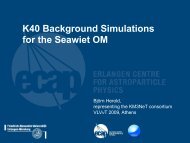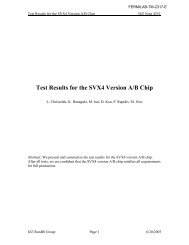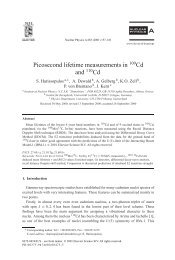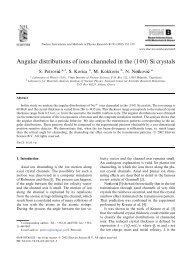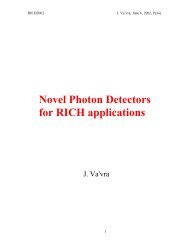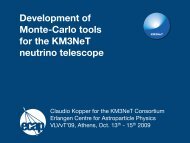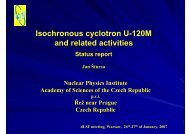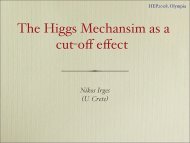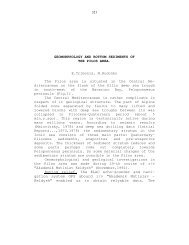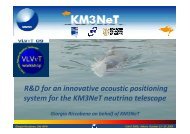"Operation and performance of the NESTOR test detector" Nucl.Instr ...
"Operation and performance of the NESTOR test detector" Nucl.Instr ...
"Operation and performance of the NESTOR test detector" Nucl.Instr ...
Create successful ePaper yourself
Turn your PDF publications into a flip-book with our unique Google optimized e-Paper software.
ARTICLE IN PRESS<br />
G. Aggouras et al. / <strong>Nucl</strong>ear <strong>Instr</strong>uments <strong>and</strong> Methods in Physics Research A 552 (2005) 420–439 423<br />
Board is via two monomode optical fibres in <strong>the</strong><br />
electro-optical cable.<br />
The Shore Board receives <strong>the</strong> data packages via<br />
<strong>the</strong> ‘up-link’, which are stored temporarily in local<br />
buffers. It broadcasts a global 40 MHz clock signal<br />
via <strong>the</strong> ‘down-link’ to <strong>the</strong> Floor Board, sends<br />
comm<strong>and</strong>s to set <strong>the</strong> run or calibration parameters<br />
<strong>and</strong> initiates functions to be executed by <strong>the</strong><br />
Housekeeping board. The ‘down-link’ can also<br />
be used to re-program <strong>the</strong> FPGA/PLDs within <strong>the</strong><br />
Floor Board <strong>and</strong> change <strong>the</strong> trigger logic parameters.<br />
The Housekeeping Board controls <strong>the</strong> distribution<br />
<strong>of</strong> power to <strong>the</strong> pmts as well as setting <strong>and</strong><br />
monitoring <strong>the</strong> pmt’s high voltage supply that is<br />
generated within <strong>the</strong> optical modules. The board<br />
also records information from <strong>the</strong> environmental<br />
sensors (compass <strong>and</strong> tilt meters, <strong>the</strong>rmometers,<br />
humidity <strong>and</strong> hygrometry) inside <strong>the</strong> Ti-sphere<br />
<strong>and</strong> from o<strong>the</strong>r sensors (e.g. water pressure <strong>and</strong><br />
water current meters) that can be mounted<br />
externally. The Housekeeping Board also operates<br />
<strong>the</strong> LED flasher units <strong>of</strong> <strong>the</strong> calibration system.<br />
The Floor Board h<strong>and</strong>les <strong>the</strong> pmt signal sensing,<br />
majority logic event triggering, waveform capture,<br />
digitization <strong>and</strong> event formatting [23,24]. It also<br />
h<strong>and</strong>les <strong>the</strong> communications with <strong>the</strong> shore board,<br />
<strong>the</strong> ‘up-link’ sending <strong>the</strong> data to shore <strong>and</strong> <strong>the</strong><br />
‘down-link’ receiving <strong>the</strong> clock signal, comm<strong>and</strong>s<br />
<strong>and</strong> downloads <strong>of</strong> operational parameters.<br />
The heart <strong>of</strong> <strong>the</strong> DAQ system is a novel ASIC<br />
developed at LBNL, <strong>the</strong> ‘‘Analog Transient<br />
Waveform Digitizer’’ (ATWD) [25]. Each ATWD<br />
has four channels, each with 128 common-ramp,<br />
10-bit, Wilkinson ADCs that, after activation,<br />
digitize all 128 samples <strong>of</strong> a selected channel. An<br />
active delay line generates <strong>the</strong> sampling so that no<br />
clocks are involved in waveform capture. The<br />
sampling rate is determined by a single external<br />
current <strong>and</strong> may be varied from 200 M samples/s<br />
to 2 G samples/s.<br />
A sampling speed <strong>of</strong> 273 M samples/s was<br />
selected in order to capture <strong>the</strong> pmt signals <strong>and</strong><br />
to recognize overlapping pulses, giving a sampling<br />
period <strong>of</strong> 3.66 ns. This gives a dynamical range<br />
(active time window) for each ATWD channel <strong>of</strong><br />
465 ns. There are five ATWDs on <strong>the</strong> Floor Board,<br />
providing 20 digitization channels. Twelve are<br />
used to digitize <strong>the</strong> pmt waveforms whilst five<br />
channels (one per ATWD) are used to digitize <strong>the</strong><br />
waveform <strong>of</strong> <strong>the</strong> 40 MHz clock signal, broadcast<br />
from <strong>the</strong> shore board; this gives a continuous<br />
check <strong>of</strong> <strong>the</strong> sampling interval stability. A fur<strong>the</strong>r<br />
channel is used to digitize <strong>the</strong> trigger majority logic<br />
signal to provide information for <strong>the</strong> synchronization<br />
<strong>and</strong> timing checks. The last two channels are<br />
used for internal calibration functions. A fur<strong>the</strong>r<br />
feature <strong>of</strong> <strong>the</strong> floor board is a st<strong>and</strong>ard pulse<br />
generator: in calibration mode, <strong>the</strong> pulse can be<br />
applied to all ATWD ‘data’ channels <strong>and</strong> digitized<br />
to continuously calibrate <strong>the</strong> gain <strong>of</strong> each channel.<br />
An event selection trigger is generated when <strong>the</strong><br />
majority coincidence requirement between pmt<br />
signals above a certain threshold level (typically<br />
30 mV), is satisfied. The trigger window is adjustable<br />
to cover different maximum distances<br />
between <strong>the</strong> optical modules. With <strong>the</strong> physical<br />
layout <strong>of</strong> <strong>the</strong> detector floor presently deployed<br />
(12 m diameter), <strong>the</strong> trigger window was set at<br />
60 ns, corresponding to <strong>the</strong> luminal transit time<br />
across <strong>the</strong> detector.<br />
The leading edge <strong>of</strong> <strong>the</strong> majority logic signal<br />
(corresponding to <strong>the</strong> time when <strong>the</strong> last <strong>of</strong> <strong>the</strong><br />
pmt pulses participating in <strong>the</strong> trigger crosses <strong>the</strong><br />
threshold level) is used to define <strong>the</strong> absolute time 2<br />
<strong>of</strong> <strong>the</strong> trigger occurrence with respect to <strong>the</strong><br />
40 MHz clock. The occurrence <strong>of</strong> <strong>the</strong> trigger<br />
initiates waveform capture by <strong>the</strong> ATWDs, reading<br />
<strong>of</strong> <strong>the</strong> environmental parameters <strong>and</strong> data<br />
transmission to <strong>the</strong> shore. The relative delays<br />
between <strong>the</strong> electronics cause <strong>the</strong> event trigger to<br />
occur at 197.5 ns within <strong>the</strong> ATWD time window.<br />
It is also possible to generate a forced trigger by<br />
comm<strong>and</strong> from <strong>the</strong> shore control system that<br />
initiates digitization <strong>and</strong> data transmission. This<br />
<strong>test</strong> function is especially useful for taking data<br />
during <strong>the</strong> deployment operations when <strong>the</strong> pmts<br />
are not powered.<br />
The sampling period, as well as <strong>the</strong> gains <strong>of</strong> <strong>the</strong><br />
ATWD channels have been continuously moni-<br />
2 This timestampcharacterizes <strong>the</strong> time <strong>of</strong> occurrence <strong>of</strong> a<br />
floor event. It is transmitted to <strong>the</strong> shore inside <strong>the</strong> data<br />
package <strong>and</strong> in a future multi-floor <strong>NESTOR</strong> detector will be<br />
used to build a global event by combining experimental<br />
information from several floors.



